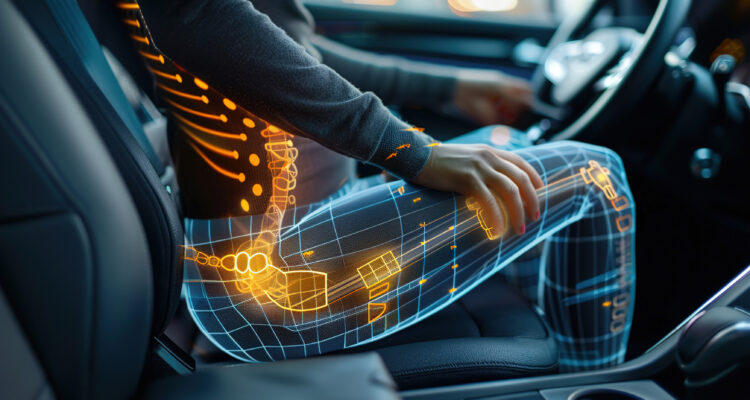Driving is an essential part of modern life, whether it’s commuting to work, running errands, or heading off on a road trip. However, spending long hours behind the wheel can take a toll on your posture and overall well-being. In fact, the average UK driver spends around 115 hours stuck in traffic each year, which could contribute to back pain and discomfort [1].
At Vavista, we care deeply about your health and comfort on the road. Therefore, in this article, we’ll explore how to avoid a bad back from driving. Additionally, we’ll discuss some simple exercises to help you stay back-pain free.

The Impact of Driving on Your Posture
Driving for extended periods can, unfortunately, lead to various musculoskeletal issues. These include back pain, headaches, neck stiffness, and shoulder discomfort [2]. Here are some common posture problems you may unknowingly be doing while driving:
- Slouching: If you slouch when you drive, it means you are sitting forward and hunched over – which can strain the lower back and lead to discomfort.
- Rounded Shoulders: Holding the steering wheel for long periods or, moreover, with tense arms can cause your shoulders to fall forward, leading to upper back and neck pain.
- Forward Head Posture: Leaning forward to see the road better can, consequently, result in a forward head posture, putting extra strain on the neck and upper back.
- Unsupported Lower Back: Without proper lumbar support, the natural curve of your lower back can, consequently, flatten, causing lower back pain [3] [4].
Tips for Maintaining Good Posture While Driving
To minimise the negative effects of driving on your back, neck and shoulders, consider these tips:
- Adjust Your Seat: Your seat should be at the right height and distance from the pedals. Your knees should be slightly bent, and your hips should be level with or slightly higher than your knees [2]. Making sure your seat is in the right position will stop you from over stretching.
- Use Lumbar Support: Lumbar support refers to any device that supports the lower region of your back while you sit down. This support helps maintain the natural curve of your spine, improve your posture, and prevent back pain associated with prolonged sitting. If your car seat lacks adequate lumbar support, you could use a special lumbar cushion or a rolled-up towel to maintain the natural curve of your lower back [3].
- Position Your Mirrors Correctly: Adjust your mirrors so you can see them without straining your neck or changing your posture [2].
- Take Breaks: On long drives, take regular breaks to stretch and move around. The highway code suggests 15 minutes for every 2 hours you spend driving. This helps prevent stiffness and promotes better circulation [3].
Simple Exercises to Stay Back Pain-Free
These simple exercises can help alleviate back pain and improve your posture. Try them after a long drive or just incorporate them into your routine once a week.
Remember: Listen to your body. If you are experiencing back pain before, during or after these exercises, stop and consult your doctor.
Shoulder Blade Squeeze: Sit or stand up straight, squeeze your shoulder blades together, hold for 5 seconds, and release. Repeat 10 times [4].
How does it help: Squeezing your shoulder blades together is also known as ‘scapular retraction’. This can strengthen the muscles between your shoulder blades, improving posture and reducing upper back tension. It can also help relieve back pain, especially from prolonged sitting.
Cat-Cow Stretch: Start on your hands and knees. Make sure your hands are directly under your shoulders and your knees are aligned with your hips. Start with the cat position. As you breathe out, round your back by tucking your chin towards your chest. Then draw your belly button towards your spine and slightly tuck your pelvis under. Hold for at least 5 seconds. Then move to cow position. As you breathe in, arch your back by lifting your head and gaze upwards. Allow your belly to drop towards the floor and tilt your pelvis slightly forward. Hold for 5 seconds and repeat 3-5 times.
How does it help: This classic yoga pose is a gentle exercise nearly anyone can do in their own home. It helps increase flexibility and reduce stiffness along your spine [4].
Chest Stretch: Stand in a doorway with your arms at a 90-degree angle to your side, in line with your shoulders. Step forward very slowly until you feel a stretch across your chest muscles. Hold for 15-20 seconds and repeat 3 times [5].
How does it help: A chest stretch can help improve your posture and reduce upper body tension, easing lower back strain. It’s used to counteract tight chest muscles that pull your shoulders forward and add stress to the spine.
Neck Stretches: Gently tilt your head to one side, bringing your ear towards your shoulder. Hold for 20-30 seconds and repeat on the other side [5].
How does it help: Neck stretching can relax muscles, boost circulation, and support the spine by strengthening the core.
Thoracic Extension: Sit on a chair with your hands behind your head, gently arch your upper back over the backrest. Hold for a few seconds and repeat 10 times [5].
How does this help: A thoracic extension stretch may help improve mid-spine mobility, reducing stiffness and back pain from poor posture. It can also enhance shoulder movements and breathing.

Driving doesn’t have to be a pain in the neck—literally! By being mindful of your posture and, furthermore, incorporating these simple exercises into your routine, you can help yourself stay comfortable and pain-free on the road.
If you enjoyed this blog, check out 5 Healthy Road Trip Habits.
Get a car insurance quote today!



